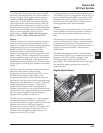
5B.2
Section 5B
EFI Fuel System
WARNING: Explosive Fuel!
Gasoline is extremely flammable and its vapors can explode
if ignited. Store gasoline only in approved containers, in
well ventilated, unoccupied buildings, away from sparks or
flames. Do not fill the fuel tank while the engine is hot or
running, since spilled fuel could ignite if it comes in contact
with hot parts or sparks from ignition. Do not start the
engine near spilled fuel. Never use gasoline as a cleaning
agent.
The EFI fuel system remains under high pressure even
when the engine is stopped. Before attempting to service
any part of the fuel system, the pressure must be relieved.
Pressure tester, (part of EFI Service Kit, see Section 2) has
an integral relief valve. Connect the black tester hose to the
test valve in the fuel rail. Route the clear hose into a
portable gasoline container. Depress the button on the tester
relief valve.
Initial Starting/Priming Procedure
Important: The EFI fuel system must be purged of air
(primed) prior to the initial start up, and/or any time
the system has been disassembled or the fuel tank run
dry.
1. Locate the electronic control unit (ECU) for the
EFI system. Check the part number on the end. If
the Part No. is 24 584 28 or higher, the ECU has a
built-in priming feature.
a. Turn the key switch to the “on/run” position.
You will hear the fuel pump cycle on and off.
When the fuel pump stops cycling
(approximately one minute), the system is
primed; start the engine.
Description
2. For plastic-cased ECU’s below 24 584 28-S, the
system can be primed by manually cycling the
fuel pump.
a. Turn the key switch to the “on/run” position.
The fuel pump will run for about three
seconds and stop. Turn the switch off and
back on to restart the fuel pump. Repeat
this procedure until the fuel pump has
cycled five times, then start the engine.
3. The system can also be primed similar to
relieving pressure.
a. Connect the pressure gauge as described
above for relieving fuel pressure. Depress
and hold the release button and crank the
engine until the air is purged and fuel is
visible in the discharge tube. If fuel is not
visible after 10 seconds, stop cranking and
allow the starter to cool for 60 seconds.
Fuel Recommendations
General Recommendations
Purchase gasoline in small quantities and store in
clean, approved containers. An approved container
with a capacity of 2 gallons or less with a pouring
spout is recommended. Such a container is easier to
handle and helps prevent spillage during refueling.
• Do not use gasoline left over from the previous
season, to minimize gum deposits in your fuel
system, and to ensure easy starting.
• Do not add oil to the gasoline.
• Do not overfill the fuel tank. Leave room for the
fuel to expand.
Fuel Type
Do not use leaded gasoline, as component damage
will result. Any costs/damages incurred as a result of
using leaded fuel will not be warranted. Use only
clean, fresh, unleaded gasoline with a pump sticker
octane rating of 87 or higher. In countries using the
Research method, it should be 90 octane minimum.
Explosive Fuel can cause fires and
severe burns.
Fuel system ALWAYS remains under
HIGH PRESSURE.
WARNING


















